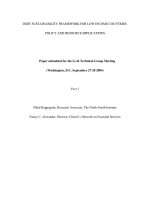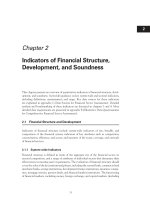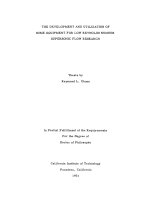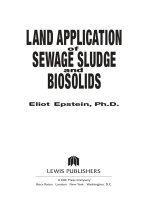Part 1 development and application of hantzsch ester and hypervalent iodine reagent
Bạn đang xem bản rút gọn của tài liệu. Xem và tải ngay bản đầy đủ của tài liệu tại đây (3.06 MB, 134 trang )
i
Part 1: COMBINATORIAL SYNTHESIS OF NITROGEN-
CONTAINING HETEROCYCLES
Part 2A: DEVELOPMENT AND APPLICATION OF HANTZSCH
ESTER
Part 2B: DEVELOPMENT AND APPLICATION OF A HYPERVALENT
IODINE REAGENT
CHE JUN
NATIONAL UNIVERSITY OF SINGAPORE
2011
ii
Part 1: COMBINATORIAL SYNTHESIS OF NITROGEN-
CONTAINING HETEROCYCLES
Part 2A: DEVELOPMENT AND APPLICATION OF HANTZSCH
ESTER
Part 2B: DEVELOPMENT AND APPLICATION OF A HYPERVALENT
IODINE REAGENT
CHE JUN
(B.Sc., Soochow University)
A THESIS SUBMITTED
FOR THE DEGREE OF DOCTOR OF PHILOSOPHY
DEPARTMENT OF CHEMISTRY
NATIONAL UNIVERSITY OF SINGAPORE
2011
i
Acknowledgements
I would like to express my greatest gratitude to my supervisor, Associate Professor Lam
Yulin, for her patient guidance, continuous flow of ideas, encouragement and invaluable
advice throughout my studies.
I would like to express my appreciation to my group members, Ching Shi Min, Fang
Zhanxiong, Fu Han, Gao Yaojun, Gao Yongnian, He Rongjun, Kong Kah Hoe, Makam
Shantha Kumar Raghavendra, Sanjay Samanta, William Lin Xijie, Woen Susanto, and Wong
Lingkai for their help and encouragement during my research.
I would also like to thank staff from the NMR, MS, Chromatography laboratories and
chemical supplies for their patience to help me greatly in analyzing compounds and
purchasing of chemicals.
I am also greatful to the National University of Singapore for awarding me the research
scholarship.
Finally, I would like to thank my family for their support.
ii
Table of Contents
Acknowledgements
i
Table of Contents
ii
Summary
vii
List of Tables
ix
List of Figures
xi
List of Schemes
xii
List of Abbreviations
xiii
List of Publications
xvi
Part 1
Chapter 1: Introduction
1.1 Combinatorial Solid-Phase Synthesis
1
1.1.1 Introduction
1
1.1.2 Solid-Phase Synthesis
1
1.1.3 Advantages and Disadvantages
2
1.2 Solid Supports
3
1.2.1 Polystyrene Resins
3
1.2.2 Polyethylene Glycol-Containg Polymers
4
1.2.3 Polyacrylamide Polymers.
5
1.3 Linkers
5
1.3.1 Acid-labile Linkers
7
1.3.2 Nucleophile- and Base-labile Linkers
7
1.3.2.1 Nucleophile-labile Linkers
8
iii
1.3.2.2 Base-labile Linkers
9
1.3.3 Photo-labile Linkers
11
1.3.4 Safety-catch Linkers
11
1.3.5 Traceless Linkers
12
1.4 Analytical Methods for Solid-Phase Synthesis
14
1.4.1 FTIR Methods
15
1.4.2 Gel Phase NMR
15
1.4.3 High-Resolution Magic Angle Spinning (HR-MAS) NMR
16
1.4.4 Spectrophotometric Methods
16
1.5 Objectives of Our Studies
16
1.6 References
17
Chapter 2 Combinatorial Solid-phase Synthesis of Hetero-annulated 1,3-Oxazin-
6-ones
2.1 Introduction
22
2.1.1 Importance of Fused 1,3-oxazin-6-ones
22
2.1.2 Synthetic Strategy
23
2.2 Results and Discussion
24
2.2.1 Synthesis of Polymer-supported Five-membered Heterocycle Amine
24
2.2.1.1 Synthesis of Polymer-supported 5-Amino-3-disubstituted-3H-
imidazole 2-1-4
24
2.2.1.2 Synthesis of Polymer-supported 5-Amino-2,3-disubstituted-3H-
imidazole 2-1-5
25
2.2.1.3 Synthesis of Polymer-supported 5-Amino-1,3-trisubstituted-1H-
pyrazole 2-1-8
27
iv
2.2.1.4 Synthesis of Polymer-supported 2-Amino-1,4,5-dimethyl-1H-pyrrole
2-1-9
28
2.2.1.5 Synthesis of Polymer-supported 5-Amino-2,3-disubstituted thiophene
2-1-10
28
2.2.2 Solid-Phase Synthesis of the 1,3-Oxazin-6-one Ring Formation
28
2.2.2.1 Solution-Phase Synthesis of 2-1-17
28
2.2.2.2 Solid-Phase Synthesis of 2-1-17
31
2.2.2.3 Solid-Phase Synthesis of 2-1-16, 2-1-18, 2-1-19 and 2-1-20
33
2.3 Conclusion
33
2.4 Experimental Section
33
2.4.1 Materials
33
2.4.2 General Procedure and Compound Characterization Data
34
2.5 References
54
Part 2A
Chapter 3 Reduction of Ketimines and Electron-Withdrawing Group Conjugated
Olefins by Polymer-Supported Hantzsch 1,4-dihydropyridine Ester
3.1 Introduction
57
3.2 Results and Discussion
59
3.2.1 Reduction of Active Alkenes
59
3.2.2 Reduction of Ketimines
64
3.2.3 Reduction of (Z)-α-cyano-β-bromomethylcinnamates and Its Analogs
66
3.3 Conclusion
67
3.4 Experiment Section
67
3.4.1 Materials
67
v
3.4.2 General Procedure and Compound Characterization Data
68
3.5 References
75
Chapter 4 TiCl
4
Catalyzed Hydrogenation of α,β-Unsaturated Ketones and
Alkylidene Malonic Diesters by Hantzsch 1,4-Dihydropyridine Ester
4.1 Introduction
78
4.2 Results and Discussion
78
4.3 Conclusion
84
4.4 Experiment Section
84
4.4.1 Materials
84
4.4.2 General Procedure and Compound Characterization Data
84
4.4.2.1 General Procedure for the Synthesis α,β-Unsaturated Ketones
84
4.4.2.2 General Procedure for the Reduction of α,β-Unsaturated Ketones
87
4.4.2.3 General Procedure for the Synthesis of Alkylidene Malonic Diesters
91
4.4.2.4 General Procedure for the Reduction of Alkylidene Malonic Diesters
92
4.5 References
94
Part 2B
Chapter 5 Applications of o-Iodosophenylphosphoric Acid in Oxidation,
Chlorination and Alkoxylation Reactions
5.1 Introduction
97
5.2 Results and Discussion
97
vi
5.2.1 Synthesis of the o-Iodosophenylphosphoric Acid
98
5.2.2 Oxidation of Phosphines
98
5.2.3 Oxidation of Sulfides
100
5.2.4 Oxiadation of Alcohols
103
5.2.5 α-Chlorination of Ketones
105
5.2.6 α-Alkoxylation and α-Hydroxylation of Ketones
107
5.3 Conclusion
109
5.4 Experiment Section
109
5.4.1 Materials
109
5.4.2 General Procedure and Compound Characterization Data
109
5.4.2.1 Procedure for the Synthesis of 5-4e
109
5.4.2.2 Procedure for the Synthesis of 5-8f
110
5.4.2.3 Procedure for the Synthesis of 5-8g
111
5.4.2.4 Procedure for the Synthesis of 5-10c
111
5.4.2.5 General Procedure for the Phosphine Oxidation by 5-1
112
5.4.2.6 General Procedure for the Sulfide Oxidation by 5-1
112
5.4.2.7 General Procedure for the Alcohol Oxidation by 5-1
112
5.4.2.8 General Procedure for α-Chlorination of the Ketones with 5-1
113
5.4.2.9 General Procedure for α-Alkoxylation of the Ketones with 5-1
113
5.5 References
114
vii
Summary
This thesis is composed by two parts: Combinatorial Synthesis of N-Containing
Heterocycles (Part 1). Development and Application of Hantzsch Ester (Part 2a);
Development and Application of Hypervalent Iodine Compounds (Part 2b);
Part 1 of this thesis focuses on combinatorial synthesis of N-containing heterocycles. In this
project, a microwave-assisted Solid-Phase Synthesis of hetero-annulated 1,3-oxazin-6-ones
has been developed. Significant rate enhancement was observed for all steps carried out
under microwave irradiation and the overall reaction time was dramatically shortened when
compared to the conventional procedures. A representative set of 20 bi- and tricyclic hetero-
annulated 1,3-oxazin-6-ones was prepared.
Part 2a comprises two projects. (i) Reduction of Ketimines and Electron-Withdrawing Group
Conjugated Olefins by Polymer-Supported Hantzsch 1,4-dihydropyridine Ester; (ii) TiCl
4
Catalyzed Hydrogenation of α,β-Unsaturated Ketones and Alkylidene Malonic Diesters by
Hantzsch 1,4-Dihydropyridine Ester. In the first project, we have demonstrated that the
reductions of (i) active alkenes, (ii) ketimines and (iii) (Z)-α-cyano-β-
bromomethylcinnamates and its analogs could be achieved with the polymer supported
Hantzsch ester in high yields and chemoselectivity. In the second project, we have shown that
the TiCl
4
-catalyzed Hantzsch 1,4-Dihydropyridine Ester reduction of α,β-unsaturated ketones
and alkylidene malonic diesters is a rapid and experimentally simple procedure for the
preparation of saturated ketones and alkyl malonic diesters.
viii
Part 2b is Development and Applications of a Hypervalent Iodine Reagent. In this project,
we have demonstrated that the hypervalent iodine compound can be used for the oxiadation
of phosphines, sulphur ethers and alcohols. In addition, we have demonstrated α-chlorination,
α-alkoxylation and α-hydroxylation of ketones with the hypervalent iodine compounds. All
the reactions can be performed efficiency with good yields.
ix
List of Tables
Table 2-1 Optimization for acylation of 2-2-7b
29
Table 2-2 Optimization for cyclization of 2-2-9
29
Table 3-1 Solvent screening for reduction of benzylidenemalononitrile 3-2
58
Table 3-2 Reduction of active alkenes using 3-1
59
Table 3-3 Optimization for reduction of 3-2g
60
Table 3-4 Optimization for reduction of nitroethene 3-2i
61
Table 3-5 Reduction of of nitroethene 3-2i
62
Table 3-6 Brønsted acid catalyzed reduction of 3-4a to 3-5a
63
Table 3-7 Reduction of ketimines by 3-1
64
Table 3-8 Cyclization of (Z)-α-cyano-β-bromomethyl cinnamates and its analogs
by 3-1
65
Table 4-1 Catalyst screening for reduction of 4-1a
78
Table 4-2 Solvent screening for reduction of 4-1a
79
Table 4-3 Reduction of α,β-unsaturated ketone anologs
81
Table 4-4 Reduction of alkylidene malonic diester anologs
83
Table 5-1 Optimization of the reaction condition for oxidation of 5-2a
97
Table 5-2 Oxidation of various phosphines
98
Table 5-3 Solvent screening for oxidation of dibenzyl sulfide 5-4a
99
Table 5-4 Microwave-assisted oxidation of dibenzyl sulfide 5-4a
100
Table 5-5 Oxidation of various sulfides
101
Table 5-6 Optimization of the reaction condition for oxidation of 5-6a to 5-7a
102
Table 5-7 Oxidation of various alcohols to carbony compounds
103
x
Table 5-8 Optimization of the reaction condition for α-chlorination of ketones
104
Table 5-9 α-Chlorination of various ketones
105
Table 5-10 α-Alkoxylation of various ketones to α-alkoxylated compounds
107
xi
List of Figures
Figure 1-1 Solid-Phase Synthesis
2
Figure 1-2 The internal molecular structure of polystyrene
3
Figure 1-3 TantaGel resin
4
Figure 1-4 Acid-labile linkers and their cleavage acids
6
Figure 1-5 General nucleophile- and base-labile linkers and their cleavage reagents
8
Figure 1-6 General representation of a nucleophile-labile linker
9
Figure 1-7 Generic representative of base-labile cleavage process
10
Figure 1-8 Safety-catch Linkers
12
Figure 2-1 Library of 2-1-16, 2-1-17, 2-1-18, 2-1-19, 2-1-20
31
Figure 3-1 Polymer-supported Hantzsch ester
56
Figure 3-2 Reduction of Ketimines and Electron-Withdrawing Group Conjugated
Olefins with 3-1
57
xii
List of Schemes
Scheme 1-1 Nucleophile promoted cleavage
9
Scheme 1-2 Base promoted cleavage
10
Scheme 1-3 Cleavage of a Photo-labile linker in SPS
11
Scheme 1-4 Cleavage of Kenner’s Safety-catch linker in SPS
12
Scheme 1-5 Aryl silyl system linker and its cleavage condition
13
Scheme 1-6 Germanium traceless linker and its cleavage condition
13
Scheme 1-7 Sulfur-based linker example
14
Scheme 1-8 Selenium-based linker example
14
Scheme 2-1 SPS of Hetero-annulated 1,3-Oxazin-6-ones
22
Scheme 2-2 Solution phase synthesis of 2-2-5
24
Scheme 2-3 Solution phase synthesis of 2-2-7
25
Scheme 2-4 Solution phase synthesis of 2-1-17a
28
Scheme 5-1 Synthesis of o-iodosophenylphosphoric acid 5-1
97
Scheme 5-2 α-Alkoxylation of 5-10b
106
Scheme 5-3 α-Hydroxylation of 5-10b
106
xiii
List of Abbreviations
Chemical shifts
AcOH
Acetic acid
ATR
Attenuated total reflection
Bu
Butyl
t-Bu
Tertiary butyl
calcd
Calculated
m-CPBA
3-Chloroperoxybenzoic acid
d
Doublet
DCM
Dichlromethane
DiEA
N,N-Diisopropylethylamine
DMAP
4-Dimethylaminopyridine
DMF
N,N-Dimethylformamide
DPP
Diphenyl phosphate
DRIFT
Diffuse reflectance infrared fourier transform
DVB
Divinyl benzene
EI
Electron ionization
equiv.
Equivalent
ESI
Electrospray ionization
Et
Ethyl
Et
2
O
Diethyl ether
EtOAc
Ethyl acetate
FTIR
Fourier trasform infrared spectroscopy
h
Hour
xiv
HBr
Hydrobromic acid
HEH
Hantzsch 1,4-dihydropyridine
HF
Hydrofluoric acid
HFIP
Hexafluoroisopropanol
HIPE
High internal phase emulsions
HNIB
[Hydroxy(p-nitrobenzenesulfonyloxy)iodo]benzene
HTIB
[Hydroxyl(tosyloxy)iodo]benzene
HR-MAS
High-resolution Magic Angle Spinning
IBX
2-Iodoxybenzoic acid
J
Coupling constant
m
Multiplet
Me
Methyl
MeOH
Methanol
min
Minute
MS
Mass spectroscopy
MW
Microwave irradiation
NADH
Reduced nicotinamide adenine dinucleotide
NADPH
Reduced nicotinamide adenine dinucleotide
phosphate
NMR
Nuclear magnetic resonance
NoE
Nuclear Overhauser Effect
PEG
Polyethylene glycol
Pepsyn K
Kieselguhr-supported Pepsyn
Ph
Phenyl
xv
PolyHIPE
Polyamide with high internal phase emulsion
PPTS
Pyridinium p-toluenesulfonate
q
Quartet
s
Singlet
SPS
Solid-phase synthesis
t
Triplet
TCA
Trichloroacetic acid
TEA
Triethyl amine
TFA
Trifluoroacetic acid
TFMSA
Trifluoromethanesulfonic acid
Tentagel
Polystyrene and polyethlene glycol copolymer
THF
Tetrahydrofuran
TLC
Thin layer chromatography
TMOF
Trimethylorthofornate
TMS
Tetramethylsilane
UV
Ultraviolet spectroscopy
Wang resin
4-Hydroxymethylphenoxy resin
xvi
List of Publications
1. Che Jun, Raghavendra Makam S, Lam Yulin. Traceless solid-phase synthesis of
heteroannulated 1,3-oxazin-6-ones. J. Comb. Chem. 2009, 11, 378-84.
2. Che, Jun, Lam, Yulin. Polymer-Supported Hantzsch 1,4-Dihydropyridine Ester: an
Efficient Biomimetic Hydrogen Source for the Reduction of Ketimines and Electron-
Withdrawing Group Conjugated Olefins. Adv. Synth. Catal. 2010, 352, 1752-1758.
3. Che Jun, Lam Yulin. Rapid and Regioselective Hydrogenation of α,β-Unsaturated
Ketones and Alkylidene Malonic Diesters Using Hantzsch Ester Catalyzed by
Titanium Tetrachloride. Synlett, 2010, 16, 2415-2420.
4. Che Jun, Lam Yulin. Development and application of o-iodosophenylphosphoric acid.
In preparation.
1
Chapter 1 Introduction
1.2 Combinatorial Solid-Phase Synthesis
1.1.1 Introduction
In 1963, Merrifield first described in the literature his method of ‘solid phase’ peptide
synthesis.
1
In this method, the first amino acid residue of the peptide to be synthesised is
bound to polystyrene beads through an ester linkage formed using the carboxyl group of the
amino acid. As a consequence the peptide subsequently synthesised is attached to the beads
via the carboxyl terminus. At the end of the synthesis the peptide produced is detached from
the polymer support by cleaving the ester linkage. Merrifield first synthesised a tetrapeptide
using this approach.
1
He soon developed a machine for automated peptide synthesis
2
and
synthesised ribonuclease A,
3
an enzyme with 124 amino acid residues. This technology has
helped pharmaceutical companies to find new drugs quickly, save significant amount of
money in preclinical development costs and ultimately changed the fundamental approach to
drug discovery.
4
In short, this novel approach revolutionalised peptide synthesis and so in
recognition of Merrifield’s achievement, he was awarded the 1984 Nobel Prize for
Chemistry.
1.1.2 Solid-Phase Synthesis
In a typical Solid-Phase synthesis reaction, a resin is reacted with the reagent A under
appropriate conditions. Subsequent reactions were carried out in a similar manner. In this
way, the molecule to be synthesized is assembled step by step on the polymer support. After
2
the synthesis, the product ABC was cleaved off the support (Figure 1-1). The product is then
available for testing in biological assays.
Figure 1-1 Solid-Phase Synthesis
1.1.3 Advantages and Disadvantages
Solid-supported chemistry is now a very useful tool in modern organic chemistry.
5
It is the
method of choice for both research and industrial synthesis of peptides
6
and
oligonucleotides.
7
Compared with the combinatorial solution-phase synthesis, Solid-Phase
Synthesis has a lot of advantages. Firstly, simple filtration and washing of the solid support
can be used as a separation and purification method thus eliminating the tedious and time-
consuming workup procedure which is often associated with solution-phase organic
synthesis. Secondly, synthesis automation is enabled. The robots can do all the operations,
such as adding reagents, filtration, washing the resin, compounds isolation and analysis.
Thirdly, a large excess of reagents may be added to drive the reactions to completion. Lastly,
ease of handling unstable or toxic intermediates that are tethered to the solid support.
However, Solid-Phase Synthesis also has some limitations. Firstly, chemical processes take
longer in Solid-Phase synthesis. Secondly, monitoring reactions and characterization of
3
intermediates can be difficult. Lastly, the scale of Solid-Phase Synthesis is limited and is
generally restricted by the amount of the solid support and its loading capacity.
1.2 Solid Supports
The use of solid supports for organic synthesis relies on three requirements. Firstly, a cross
linked, insoluble, but solvent swellable polymeric material that is inert to the reaction
condition of synthesis. Secondly, the synthetic procedure should be compatible with the
linker and the solid phase. Lastly, some means of linking the substrate to the solid phase that
permits selective cleavage of the product from the solid support during synthesis for analysis
of the reaction. Listed below are some examples of the most commonly used solid supports in
Solid-Phase reactions.
1.2.1 Polystyrene Resins
Figure 1-2 The internal molecular structure of polystyrene
Polystyrene resins (Figure 1-2) are the most widely used solid supports in the Solid-Phase
Synthesis. The physicochemical properties of this resin depend heavily on the amount of
4
cross-linking of the polystyrene. The addition of 1% DVB as a cross-linker has proven to be
an optimum compromise between good swelling property (low cross-linking) and mechanical
stability (high cross-linking). The resulting resin has good swelling properties in many
solvents, such as THF, DCM, DMF or toluene. In addition, it is stable enough for the
working up procedure. However, when the protonic solvent like water or methanol was used
for the reaction, it would shrink the resin
8
.
Under this situation, it is necessary to perform the
reactions in a mixture of good swelling solvent and protonic solvent.
1.2.2 Polyethylene Glycol-Containg Polymers
Figure 1-3 TantaGel Resin
As an alternative to the hydrophobic polystyrene resins, hydrophilic copolymers of
polystyrene and polyethylene glycol (PEG) were developed. The most representative resin is
TentaGel Resin (Figure 1-3) which was developed by Bayer and Rapp.
9
The resin consists of
PEG attached to cross-linked polystyrene through an ether linkage. This type of resin
combines the advantages of the soluble PEG support with the insolubility and handling
characteristics of the polystyrene bead. Compared with cross-linked polystyrene resins,
TentaGel Resin is also available with various linkers allowing the coupling with a wide
variety of building locks. Furthermore, it has better swelling ability than the cross-linked
polystyrene resins in organic and polar solvents,
10
such as water, which makes this support a
5
good alternative in Solid-Phase synthesis. However its hydroscopic character and chemical
instability in strongly basic condition limit its application as a solid support.
1.2.3 Polyacrylamide Polymers
In the 1970s and 1980s, various resins were developed on a polyacrylamide basis as these
polymers have very good swelling properties in both aprotic (DMF, pyridine, DCM) and
protic (methanol, water) solvents.
11
In addition, a series of copolymers were also introduced.
Pepsyn K was among these, in which the polyacrylamide resin was polymerized to an
inorganic kieselguhr matrix. And it is the first polymeric support used in continuous-flow
solid-phase synthesis.
12
However, its loading capacity is low (< 0.1mmol/g). PolyHIPE is
another representative of polyacrylamide copolymers. It is prepared by polymerizing
polyamide into macroporous polystyrene particles.
13
Compared with Pepsyn K, it has a high
loading capacity (up to 5 mmol/g).
1.3 Linkers
Linker is central in the design of a solid-phase organic synthesis scheme as it will dictate
whether the compounds stay on the solid phase for assay, or whether mild and selective
conditions are available to cleave the compounds away from the support for solution phase
assay. It is usually a bifunctional molecule that connects the first building block in the solid-
phase synthesis to the solid support.
12
It may also be considered as a protecting group for the
functional groups of the final product.
6
Figure 1-4 Acid-labile linkers and their cleavage acids
In the past 40 years, a large variety of linkers have been developed to be used in the
multistep organic synthesis. Therefore, choosing the right linker for the solid phase synthesis
is crucial. There are three main considerations for the selection of a linker. Firstly, the linker
should be inert to the subsequent reactions performed on the substrate. Secondly, the linker
7
should be selectively cleavable to allow the release of the product from the resin throughout
the synthesis. Lastly, the linker should be chosen to minimize its structural and chemical
effects on the sought after properties of the synthesized compounds. Various linkers are
described below.
1.3.1 Acid-labile Linkers
Most of the linkers used today in Solid-Phase Peptide Synthesis are acid-labile linkers.
These linkers generally contain a benzylic structure since the stability of the cation formed on
cleavage can be easily modulated by the introduction of various electron-donating
substituents on the ortho or para positions of the phenyl ring. Chemicals such as TFMSA, HF,
HBr, TFA, PPTS, AcOH and HFIP can be employed as cleavage reagents. Cleavage of the
linkers follows the S
N
1-type mechanism involving the cleavage of the carbon-heteratom
bond. Figure 1-4 shows some general acid-labile linkers and their cleavage acids. The most
recent acid-laible linker reported is an ester type linker which upon cleavage releases the
glycans as carbamate protected aminoglycosides was successfully employed in the sequential
assembly of L-idose and azido glucose monosaccharide building blocks to heparan sulfate
precursors.
22b
1.3.2 Nucleophile- and Base-labile Linkers
Nucleophile- and base-labile linkers are resins based on classical organic chemistry
reactions ie the compounds are released either by nucleophilic substitution reactions or by an
elimination reaction promoted by a base. The reactivity and stability of these linkers are
rationalized according to their chemical properties, in particular the pKa of the linker or









